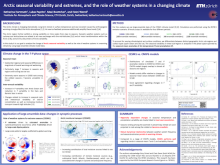Arctic seasonal variability and extremes, and the role of weather systems in a changing climate
Katharina
Hartmuth
Institute for Atmospheric and Climate Science, ETH Zurich, Switzerland
Poster
The effects of global warming are strongly amplified in the Arctic, causing rapidly rising temperatures and ongoing dramatic loss of sea ice, which itself is subject to large interannual variability. We investigate changes in seasonal-mean temperature and precipitation, its variability and extremes, using large-ensemble climate model data with a RCP8.5 forcing scenario for historical (S2000) and end-of-century projections (S2100).
Our results reveal regionally and seasonally dependent changes in Arctic interannual temperature and precipitation variability that are strongly linked to sea-ice loss. We show a doubling in precipitation variability over the Arctic Ocean and a significant reduction in temperature variability in the Barents Sea. Extremely warm seasons in S2000 rank among the coldest seasons or become unrealistic in S2100.
We further show the key role of large-scale weather systems for shaping seasonal temperature and precipitation extremes in the Arctic which persists under climate warming.
Our results reveal regionally and seasonally dependent changes in Arctic interannual temperature and precipitation variability that are strongly linked to sea-ice loss. We show a doubling in precipitation variability over the Arctic Ocean and a significant reduction in temperature variability in the Barents Sea. Extremely warm seasons in S2000 rank among the coldest seasons or become unrealistic in S2100.
We further show the key role of large-scale weather systems for shaping seasonal temperature and precipitation extremes in the Arctic which persists under climate warming.

Poster file
